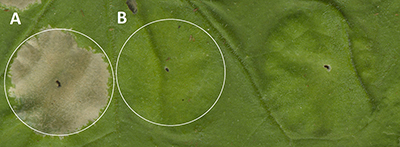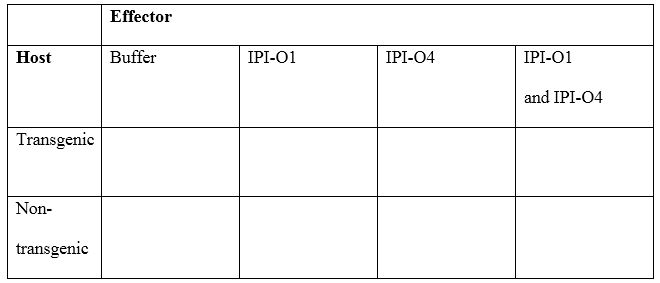R genes and effectors
Pathogenesis, or how pathogens cause disease, is an important concept in plant pathology. The study of pathogenesis in plant pathology has rapidly expanded and is now a significant portion of plant pathology research conducted at the level of molecular host-pathogen interactions. This laboratory exercise directly addresses some of these pathogenesis concepts, specifically the interaction of host R gene products with pathogen effectors, and the outcome of these interactions (e.g., the hypersensitive response).
Resistance genes (referred to as
R genes) are host plant genes that confer resistance to a pathogen. R genes encode a protein (R protein) that detects the pathogen and elicits a resistance response.
Effectors are pathogen proteins involved in disease development. The pathogen uses them to infect and cause disease. When a host R protein detects an effector, the cell initiates a resistance response. The response can be the death of the infected host cell, called a
hypersensitive response. This localized cell death prevents the pathogen from spreading and colonizing the plant. R proteins may interact directly with effectors to detect the pathogen, or there may be other proteins involved (Gururani et al. 2012).
Introduction
This activity utilizes
Phytophthora infestans effectors and potato resistance genes in a model system developed by Dr. Dennis A. Halterman at the USDA (Halterman et al. 2010).
P. infestans is the causal agent of the potato late blight disease (Schumann and D’Arcy 2000). Potato plants with the RB protein can recognize the presence of effector IPI-O1 from
P. infestans. When
P. infestans infects a plant expressing RB, the effector is detected, which elicits a hypersensitive cell death response (HR) in infected plant cells. In this exercise, students will investigate the interaction of a second effector, the related IPI-O4, with the RB protein and with IPI-O1.
Click here for instructor Note #1: Discussion of learning goals
Transgenic tobacco expressing the
RB gene is used for the experiments. Students infiltrate the leaves of
RB-expressing transgenic tobacco with
Agrobacterium tumefaciens capable of expressing the effectors IPI-O1 and IPI-O4 from
P. infestans in the plant.This experiment also provides a platform for discussion of transgenic organisms and their use in agriculture and research.
Materials:
-
P. infestans effectors IPI-O4 and IPI-O1 transformed
A. tumefaciens inoculum
-
1 ml syringes
-
1 transgenic tobacco plant expressing the
RB gene and 1 non-transgenic tobacco plant (per group)
-
Permanent marker
-
Pot labels
Click here for instructor note #2: Preparation of Materials
Protocol:
For this exercise, you will look at the interaction between
Phytophthora infestans effectors and potato R-genes. You will NOT be using the pathogen
P. infestans, instead you will use
Agrobacterium tumefaciens that has been transformed with an effector gene from
P. infestans (the T region has been removed from the Ti plasmid and the effector gene has been added) (Agrios 2005). Therefore, plants inoculated with these transformed strains of
A. tumefaciens will express the effector in the infected cells. You will be using two different strains, one with the effector gene IPI-O1 and one with the effector gene IPI-O4.
The plants you will inoculate are NOT potato plants but transgenic tobacco plants that express a resistance gene (the
RB gene) that recognizes the presence of the IPI-O1 effector.
Before starting you may want to visit this YouTube video to see infiltration of a tobacco leaf:
https://www.youtube.com/watch?v=GHc7PU_jG2M.
-
Label plants as transgenic or non-transgenic. Also label with a group name and section.
-
Use the permanent marker and label four leaves on each plant with numbers 1-4. These numbers correspond to the following treatments:
1) Buffer
2) IPI-O4
3) IPI-O1
4) IPI-O4 followed by IPI-O1 a day later
-
You will use the syringe to infiltrate an area of the leaf about the size of a quarter with the inoculum following the treatments above. Watch the demonstration carefully and practice with buffer on an unlabeled leaf.
-
Infiltrate using the appropriate inoculum on each leaf for both plants. Circle the infiltrated area with the permanent marker.
-
Tomorrow someone from your group will need to come in to lab for a few minutes to infiltrate number 4 with IPI-O1. Infiltration with IPI-O1 the second day must be done in the same area as the IPI-O4 infiltration, (which should have been circled and labeled using a marker).
Observations and questions for students:
Question at the start of the experiment
Assuming the interaction is gene-for-gene and that it leads to a hypersensitive response, what do you expect to see next week in each treatment?
Data collection and questions at the end of the experiment
Examine your plants for a resistance response. You should get either a hypersensitive response or no response (compare to the negative control).
Figure 1 below shows what the HR response should look like. However, it is possible that you may get an intermediate response where the inoculated area has patches of healthy tissue mixed with patches of dead tissue. Record your results in
Table 1 below.
 |
Figure 1: Transgenic tobacco plant (RB gene) leaf infiltrated with two different
A. tumefaciens strains, each expressing a different effector from P. infestans.
Circle A shows a hypersensitive response to one of the effectors. Circle B shows
no reaction to a different effector. |
 |
|
Table 1. Experimental results can be recorded in the table shown. |
Is there is a gene-for-gene interaction as assumed? Explain. Do both effectors have a direct interaction with the RB protein? How do you know that the interaction is or is not gene-for-gene?
What is the advantage to using transgenic organisms in this type of research?
Click here for instructor Note #3: Explanation of the expected results
Literature Cited
Agrios, G. 2005. Plant Pathology, 5th edition. Elsevier Academic Press, Burlington, MA.
Gururani, A. M., Venkatesh, J., Upadhyaya, C. P., Nookarajuc, A., Pandey, S. K, Park, S. E. 2012. Plant disease resistance genes: Current status and future directions. Physiological and Molecular Plant Pathology 78:51-65.
Halterman, D. A., Chen, Y., Sopee, J., Berduo-Sandoval, J. and Sánchez-Pérez, A. 2010. Competition between
Phytophthora infestans effectors leads to increased aggressiveness on plants containing broad-spectrum late blight resistance. PLoS ONE 5:e10536.
Schumann, G. L., and D’Arcy, C. J. 2000. Late blight of potato and tomato. The Plant Health Instructor. DOI: 10.1094/PHI-I-2000-0724-01
Instructor Notes
